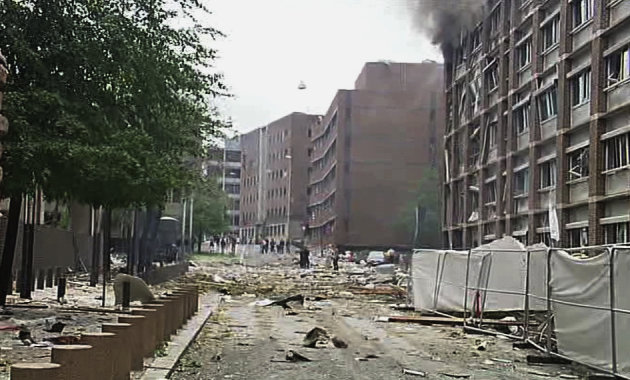
OSLO (Reuters) - A bomb ripped through Oslo's central government district on Friday and a gunmen dressed as a policeman then opened fire at a youth camp on a nearby island, killing 17 people altogether, police said.
In the biggest such attack in western Europe since the London transport bombings in 2005, seven died when the bomb exploded on the Norwegian capital in mid-afternoon scattering glass, shattered masonry and twisted steel across the streets.
Shortly afterwards, a gunman opened fire at the youth camp of the ruling political party on Utoeya island, north-west of Oslo. Police said nine or 10 people were killed and they believed the two attacks were linked. The gunman was arrested.
The bomb, which shook the city center at around 3:30 p.m. (1330 GMT), blew out the windows of the Prime Minister's building and damaged the finance and oil ministries.
"People ran in panic," said bystander Kjersti Vedun.
With police advising people to evacuate central Oslo, apparently in fear of more attacks, Prime Minister Jens Stoltenberg told Norwegian TV2 television in a phone call that the situation was "very serious." He said that police had told him not to say where he was speaking from.
A Reuters witness saw soldiers taking up positions in Oslo.
The gunman, described by a police official as tall and blond, was reported by Norwegian media to have taken advantage of the confusion caused by the bombing to attack the summer camp of Stoltenberg's Labour party youth section.
"There was a lot of shooting ... We hid under a bed. It was very terrifying," a young woman at the camp told British Sky television.
There was no clear claim of responsibility and while the attacks appeared to bear some, but by no means all, of the hallmarks of an Islamist militant assault, analysts said it was too early to draw any conclusions.
"This is a terror attack. It is the most violent event to strike Norway since World War Two," said Geir Bekkevold, an opposition parliamentarian for the Christian Peoples Party.
NO CLUES YET FROM DETAINED MAN
Lilit Gevorgyan, analyst at IHS Global Insight, said the most likely suspects were al-Qaeda-linked or inspired groups, but added:
"As the news continues trickling in from Utoeya, however, right-wing extremist groups or even a lone perpetrator with army training or access to ammunition and weaponry could be behind the plot."
Deputy Oslo police chief Sveining Sponheim told reporters that the gunman in the Utoeya shootings had been disguised in a blue police-style uniform but had never been employed by the police.
He said that the police also believed that the man may have been involved in both the Oslo bombing and the shootings. So far, the detained man had not said anything to the police.
NATO member Norway has been the target of threats before over its involvement in conflicts in Afghanistan and Libya.
The attack came just over a year after three men were arrested on suspicion of having links to al Qaeda and planning to attack targets in Norway. It also came less than three months after U.S. forces killed Osama bin Laden in a raid on his hideout in Pakistan.
Violence or the threat of it has already come to the other Nordic states: a botched bomb attack took place in the Swedish capital Stockholm last December and the bomber was killed.
Denmark has received repeated threats after a newspaper published cartoons of the Prophet Mohammad in late 2005, angering Muslims worldwide.
In Oslo, the building of a publisher which recently put out a translation of a Danish book on the cartoon controversy was also affected, but was apparently not the target.
Police have been on the alert for complex gun-and-bomb attacks on European cities since the assault by 10 gunmen on India's financial capital Mumbai in November 2008 which killed 166 people. The Oslo attacks, though hitting two targets, were not simultaneous and the delay between them left open the possibility of a single perpetrator.
Madrid suffered an Islamist militant bomb attack on commuter trains in 2004 that killed 191 people. Four suicide bombers killed 52 people in an attack on London's transport system in 2005.
The Oslo district attacked is the very heart of power in Norway, with several other key administration buildings nearby. Nevertheless, security is not tight given the lack of violence in the past.
The Reuters correspondent said the streets had been fairly quiet in mid-afternoon on a Friday in high summer, when many Oslo residents take vacation or leave for weekend breaks.
The failed December attack in Stockholm was by a Muslim man who grew up in Sweden but said he had been angered by Sweden's involvement in the NATO-led force in Afghanistan and the Prophet Mohammad cartoons.
That attack was followed weeks later by the arrest in Denmark of five men for allegedly planning to attack the newspaper which first ran the Mohammad cartoons.
In July 2010, Norwegian police arrested three men for an alleged plot to organize at least one attack on Norwegian targets and said they were linked to individuals investigated in the United States and Britain.
Political violence is virtually unknown in a country known for awarding the Nobel Peace Prize and mediating in conflicts, including in the Middle East and Sri Lanka. LINK


